2003 PONTIAC GRAND PRIX warning light
[x] Cancel search: warning lightPage 255 of 378
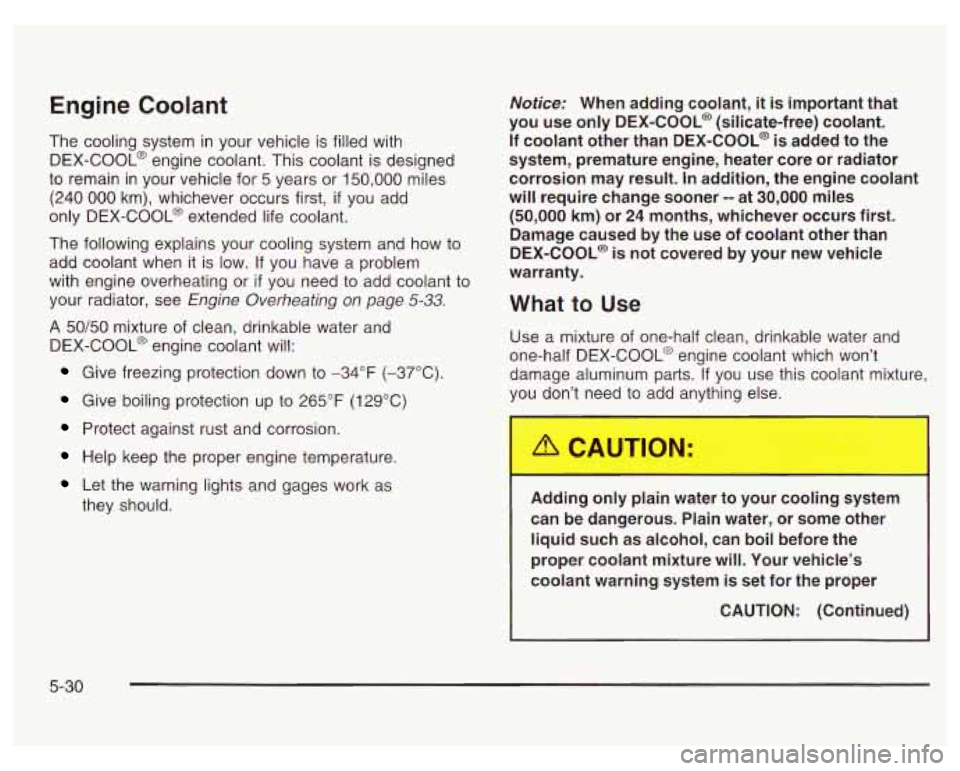
Engine Coolant
The cooling system in your vehicle is filled with
DEX-COOL@ engine coolant. This coolant is designed
to remain in your vehicle for
5 years or 150,000 miles
(240
000 km), whichever occurs first, if you add
only DEX-COOL@ extended life coolant.
The following explains your cooling system and how to
add coolant when it is low.
If you have a problem
with engine overheating or
if you need to add coolant to
your radiator, see Engine Overheating on page
5-33.
A 50/50 mixture of clean, drinkable water and
DEX-COOL@ engine coolant will:
Give freezing protection down to -34°F (-37°C).
Give boiling protection up to 265°F (129°C)
Protect against rust and corrosion.
Help keep the proper engine temperature.
Let the warning lights and gages work as
they should.
Notice: When adding coolant, it is important that
you use only
DEX-COOL@ (silicate-free) coolant.
If coolant other than DEX-COOL@ is added to the
system, premature engine, heater core or radiator
corrosion may result. In addition, the engine coolant
will require change sooner
-- at 30,000 miles
(50,000 km) or 24 months, whichever occurs first.
Damage caused by the use
of coolant other than
DEX-COOL@ is not covered by your new vehicle
warranty.
What to Use
Use a mixture of one-half clean, drinkable water and
one-half DEX-COOL@ engine coolant which won’t
damage aluminum parts. If you use this coolant mixture,
you don’t need to add anything else.
1 ---.-.g only p n water to your c 3 system
can be dangerous. Plain water, or some other
liquid such as alcohol, can boil before the
proper coolant mixture will. Your vehicle’s
coolant warning system is set
for the proper
CAUTION: (Continued)
I
5-30
Page 258 of 378
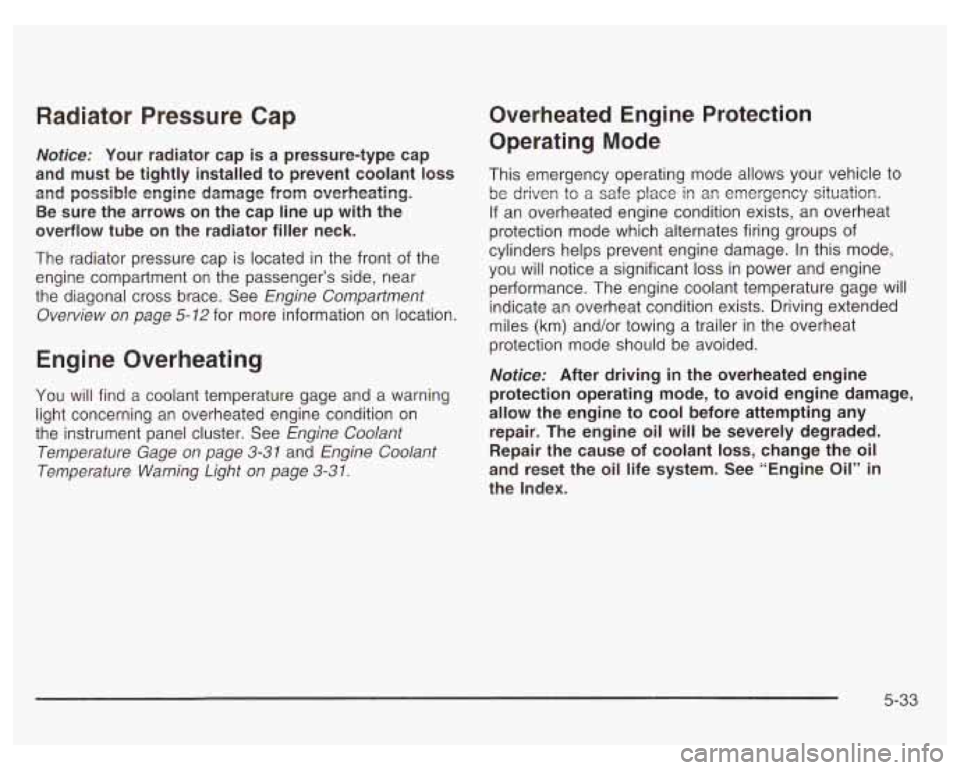
Radiator Pressure Cap
Notice: Your radiator cap is a pressure-type cap
and must be tightly installed to prevent coolant
loss
and possible engine damage from overheating.
Be sure the arrows on the cap line up with the
overflow tube
on the radiator filler neck.
The radiator pressure cap is located in the front of the
engine compartment on the passenger’s side, near
the diagonal cross brace. See Engine Compartment
Overview on page
5-12 for more information on location.
Engine Overheating
You will find a coolant temperature gage and a warning
light concerning an overheated engine condition on
the instrument panel cluster. See Engine Coolant
Temperature Gage
on page 3-31 and Engine Coolant
Temperature Warning Light
on page 3-31.
Overheated Engine Protection
Operating Mode
This emergency operating mode allows your vehicle to
be driven tu
a safe place in an emergency situation.
If an overheated engine condition exists, an overheat
protection mode which alternates firing groups of
cylinders helps prevent engine damage. In this mode,
you will notice a significant
loss in power and engine
performance. The engine coolant temperature gage will
indicate an overheat condition exists. Driving extended
miles (km) and/or towing a trailer in the overheat
protection mode should be avoided.
Nofice: After driving in the overheated engine
protection operating mode, to avoid engine damage,
allow the engine to cool before attempting any
repair. The engine oil will be severely degraded.
Repair the cause of coolant
loss, change the oil
and reset the oil life system. See “Engine Oil”
ir
the Index.
5-33
Page 275 of 378
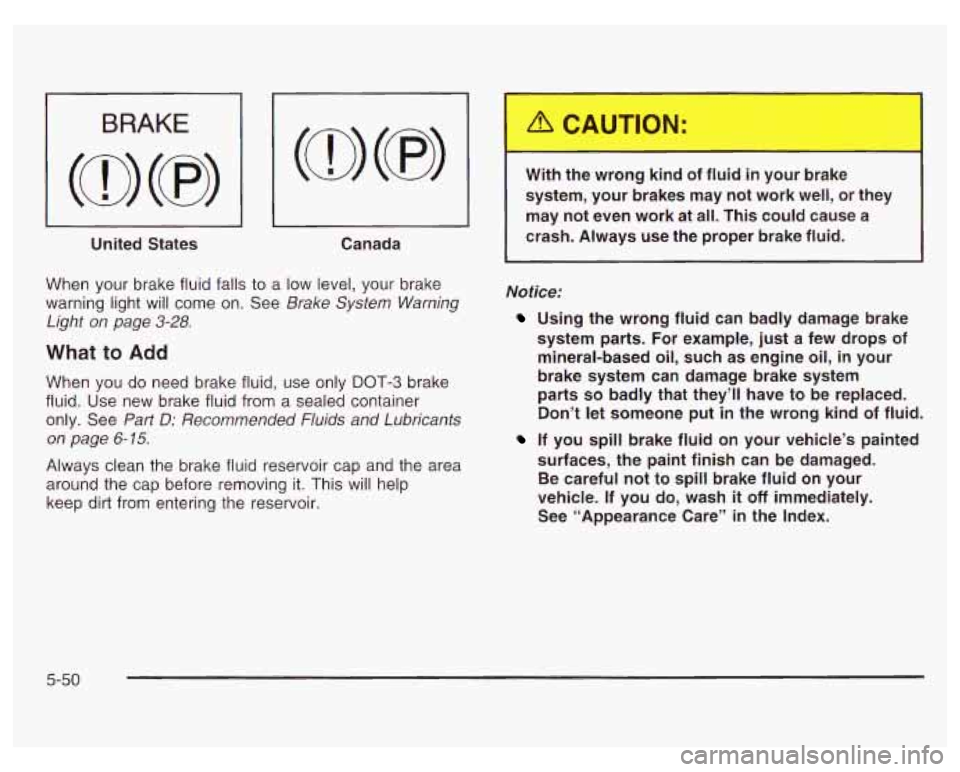
United States
~~
Canada
When your brake fluid falls to a low level, your brake
warning light will come on. See Brake System Warning
Light on page
3-28.
What to Add
When you do need brake fluid, use only DOT-3 brake
fluid. Use new brake fluid from a sealed container
only. See Part D: Recommended Fluids and Lubricants
on page
6- 15.
Always clean the brake fluid reservoir cap and the area
around the cap before removing it. This will help
keep
dirt from entering the reservoir.
r
With the wrong kind of fluid in your brake
system, your brakes may not work well, or they
may not even work at all. This could cause a
crash. Always
use the proper brake fluid.
Notice:
Using the wrong fluid can badly damage brake
system parts. For example, just a few drops of mineral-based oil, such as engine oil, in your
brake system can damage brake system
parts
so badly that they’ll have to be replaced.
Don’t let someone put in the wrong kind of fluid.
If you spill brake fluid on your vehicle’s painted
surfaces, the paint finish can be damaged.
Be careful not to spill brake fluid on your
vehicle. If you do, wash
it off immediately.
See “Appearance Care” in the Index.
5-50
Page 297 of 378
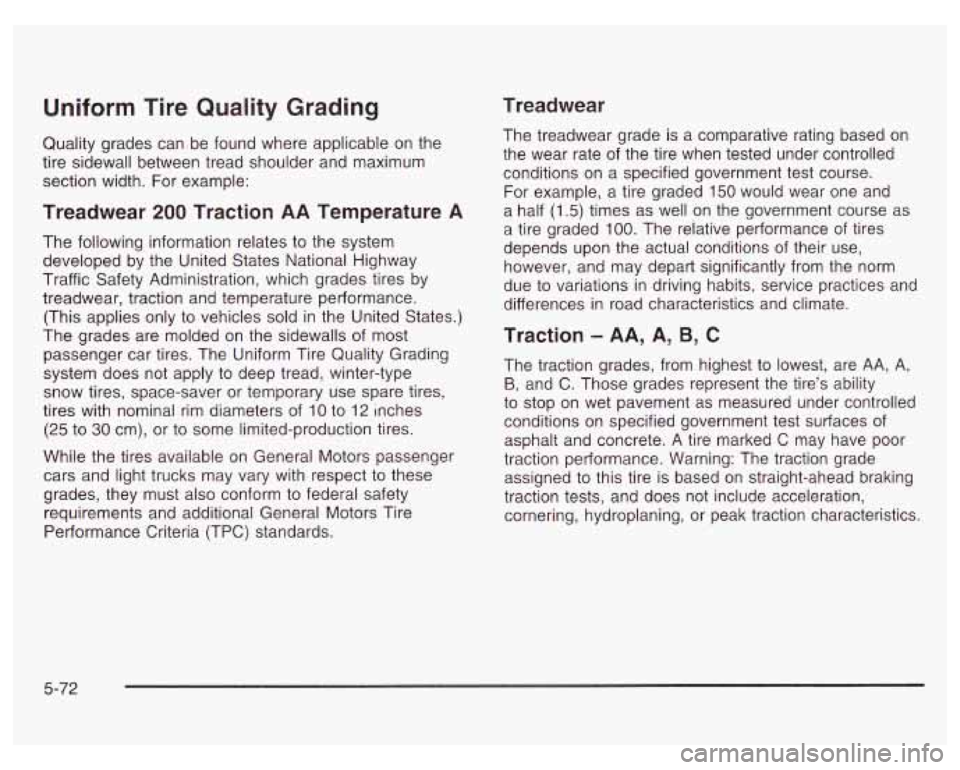
Uniform Tire Quality Grading
Quality grades can be found where applicable on the
tire sidewall between tread shoulder and maximum
section width. For example:
Treadwear 200 Traction AA Temperature A
The following information relates to the system
developed by the United States National Highway
Traffic Safety Administration, which grades tires by
treadwear, traction and temperature performance.
(This applies only to vehicles sold in the United States.)
The grades are molded on the sidewalls of most
passenger car tires. The Uniform Tire Quality Grading
system does not apply to deep tread, winter-type
snow tires, space-saver or temporary use spare tires,
tires with nominal rim diameters of
10 to 12 inches
(25 to
30 cm), or to some limited-production tires.
While the tires available on General Motors passenger
cars and light trucks may vary with respect to these
grades, they must also conform to federal safety
requirements and additional General Motors Tire
Performance Criteria (TPC) standards.
Treadwear
The treadwear grade is a comparative rating based on
the wear rate of the tire when tested under controlled
conditions on a specified government test course.
For example, a tire graded
150 would wear one and
a half
(1.5) times as well on the government course as
a tire graded
100. The relative performance of tires
depends upon the actual conditions of their use,
however, and may depart significantly from the norm
due to variations in driving habits, service practices and
differences in road characteristics and climate.
Traction - AA, A, 9, C
The traction grades, from highest to lowest, are AA, A,
B, and C. Those grades represent the tire’s ability
to stop on wet pavement as measured under controlled
conditions on specified government test surfaces
of
asphalt and concrete. A tire marked C may have poor
traction performance. Warning: The traction grade
assigned to this tire is based on straight-ahead braking
traction tests, and does not include acceleration,
cornering, hydroplaning, or peak traction characteristics.
5-72
Page 360 of 378
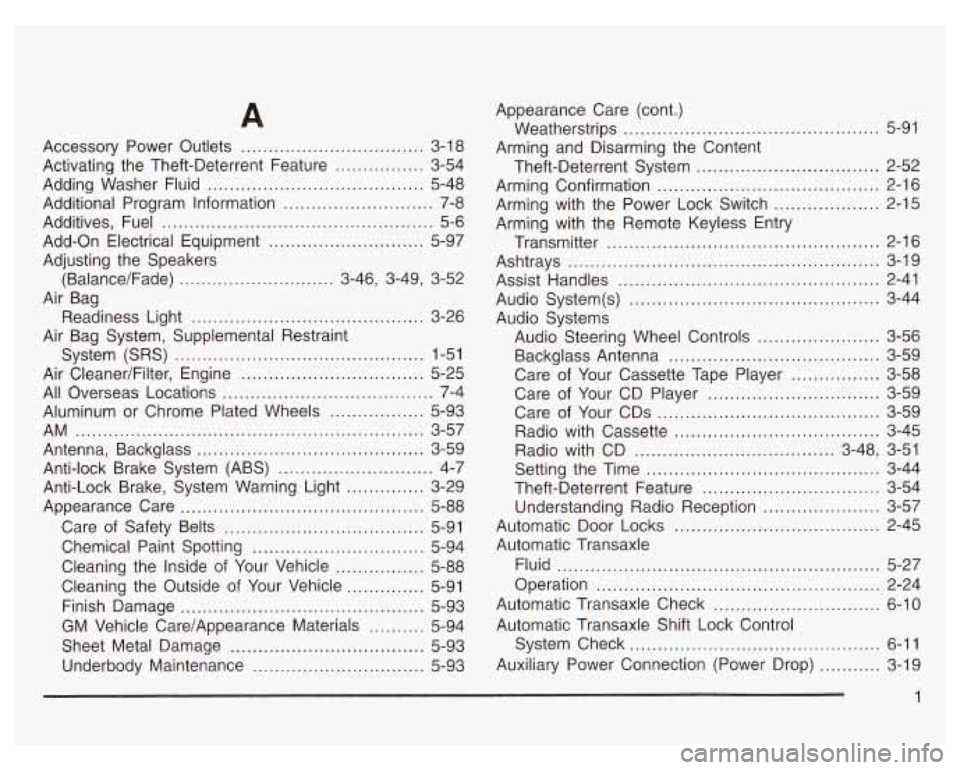
A
Accessory Power Outlets ................................. 3-1 8
Activating the Theft-Deterrent Feature
................ 3-54
Adding Washer Fluid
....................................... 5-48
Additional Program Information
........................... 7-8
Additives, Fuel
................................................. 5-6
Add-on Electrical Equipment
............................ 5-97
Adjusting the Speakers
(Balance/Fade)
............................ 3-46, 3-49, 3-52
Air Bag Readiness Light
.................................... ~ ~ ~ ~ ~ ~ ~ 3-26
Air Bag System, Supplemental Restraint
System (SRS)
............................................. 1-51
Air Cleaner/Filter, Engine
................................. 5-25
All Overseas Locations ...................................... 7-4
Aluminum or Chrome Plated Wheels
............. 5-93
Antenna, Backglass
......................................... 3-59
Anti-lock Brake System (ABS)
............................ 4-7
Anti-Lock Brake, System Warning Light
.............. 3-29
Appearance Care
............................................ 5-88
Care of Safety Belts
.................................... 5-91
Cleaning the Inside of Your Vehicle
................ 5-88
Cleaning the Outside of Your Vehicle
.............. 5-91
Finish Damage
............................................ 5-93
GM Vehicle Care/Appearance Materials
.......... 5-94
Underbody Maintenance
............................... 5-93
AM
........................................................... 3-57
Chemical Paint Spotting
............................... 5-94
Sheet Metal Damage
................................... 5-93 Appearance
Care (cont.)
Weatherstrips
.......................................... 5-91
Arming and Disarming the Content
Theft-Deterrent System
................................. 2-52
Arming Confirmation
........................................ 2-16
Arming with the Power Lock Switch
................... 2-15
Arming with the Remote Keyless Entry
Transmitter
................................................. 2-16
Ashtrays
............. ............................... 3-19
Assist Handles
.... ................................... 2-41
Audio System(s)
......................................... 3-44
Audio Systems Audio Steering Wheel Controls
...... ........ 3-56
Backglass Antenna
...................................... 3-59
Care of Your Cassette Tape Player
................ 3-58
Care of Your CD Player
............................... 3-59
Care of Your CDs
........................................ 3-59
Radio with Cassette
..................................... 3-45
Radio with CD .................................... 3-48, 3-51
Setting the Time
.......................................... 3-44
Theft-Deterrent Feature
................................ 3-54
Understanding Radio Reception
..................... 3-57
Automatic Door Locks
..................................... 2-45
Automatic Transaxle
Fluid
.......................................................... 5-27
Operation
................................................... 2-24
Automatic Transaxle Check
.............................. 6-10
Automatic Transaxle Shift Lock Control
System Check
............................................. 6-11
Auxiliary Power Connection (Power Drop)
........... 3-19
1
Page 361 of 378
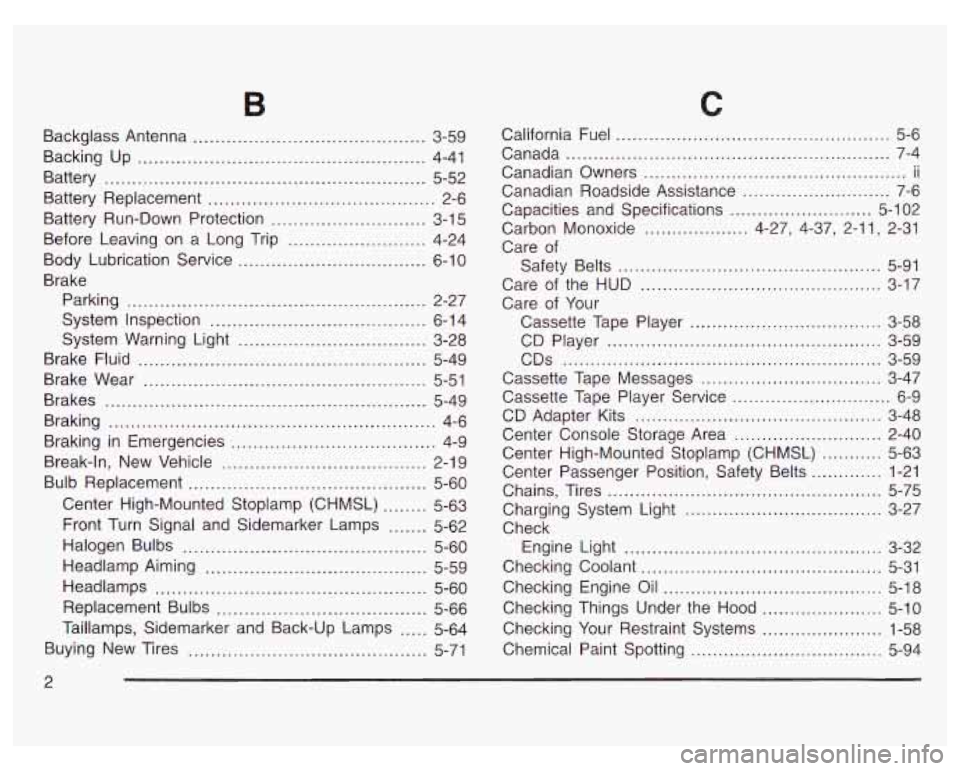
Backglass Antenna .......................................... 3-59
Backing Up .................................................... 4-41
Battery .......................................................... 5-52
Battery Replacement ......................................... 2-6
Battery Run-Down Protection ............................ 3-1 5
Before Leaving on a Long Trip ......................... 4-24
Body Lubrication Service .......................... 6-10
Brake
Parking
...................................................... 2-27
System Inspection ....................................... 6-1 4
System Warning Light .................................. 3-28
Brake Fluid .................................................... 5-49
Brake Wear ................................................... 5-51
Brakes .......................................................... 5-49
Braking ........................................................... 4-6
Break-In, New Vehicle ..................................... 2-19
Bulb Replacement ........................................... 5-60
Center High-Mounted Stoplamp (CHMSL) ........ 5-63
Front Turn Signal and Sidemarker Lamps ....... 5-62
Halogen Bulbs ............................................ 5-60
Headlamp Aiming ........................................ 5-59
Headlamps ................................................. 5-60
Replacement Bulbs ...................................... 5-66
Taillamps, Sidemarker and Back-up Lamps ..... 5-64
Buying New Tires ........................................... 5-71
Braking in Emergencies ..................................... 4-9
C
California Fuel .................................................. 5-6
Canada ........................................................... 7-4
Canadian Owners ................................................ ii
Canadian Roadside Assistance ........................... 7-6
Capacities and Specifications .......................... 5-1 02
Carbon Monoxide ................... 4-27, 4-37, 2-1 1, 2-31
Care of
Safety Belts ................................................ 5-91
Care of the HUD ............................................ 3-17
Care of Your
Cassette Tape Player
................................... 3-58
CD Player .................................................. 3-59
Cassette Tape Messages ................................. 3-47
Cassette Tape Player Service ............................. 6-9
Center Console Storage Area ........................... 2-40
Center High-Mounted Stoplamp (CHMSL) ........... 5-63
Center Passenger Position, Safety Belts ............. 1-21
Chains, Tires .................................................. 5-75
Check
Checking Coolant
............................................ 5-31
Checking Things Under the Hood ...................... 5-10
Checking Your Restraint Systems ...................... 1-58
CDS .......................................................... 3-59
CD Adapter Kits ............................................. 3-48
Charging System Light .................................... 3-27
Engine Light ............................................... 3-32
Checking Engine Oil ........................................ 5-18
Chemical Paint Spotting ................................... 5-94
2
Page 362 of 378
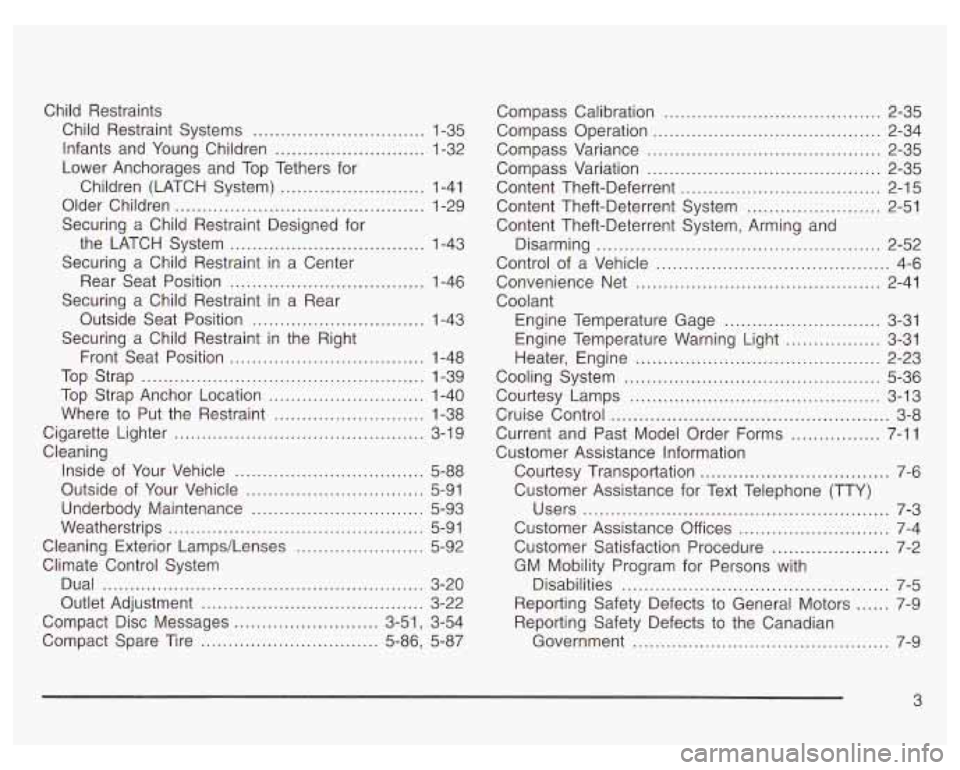
Child Restraints Child Restraint Systems
............................... 1-35
Infants and Young Children
........................... 1-32
Lower Anchorages and Top Tethers for
Children (LATCH System)
.......................... 1-41
Older Children
............................................. 1-29
Securing a Child Restraint Designed for
the LATCH System
................................... 1-43
Securing a Child Restraint in a Center
Rear Seat Position
................................... 1-46
Securing a Child Restraint in a Rear
Outside Seat Position
............................... 1-43
Securing a Child Restraint in the Right
Front Seat Position
................................... 1-48
Top Strap
................................................... 1-39
Top Strap Anchor Location
.......... ........... 1-40
Where
to Put the Restraint ..... ............... 1-38
Cigarette Lighter
............................................. 3-1 9
Cleaning Inside of Your Vehicle
.................................. 5-88
Outside of Your Vehicle
................................ 5-91
Underbody Maintenance
............................... 5-93
Weatherstrips
.............................................. 5-91
Cleaning Exterior Lamps/Lenses
....................... 5-92
Climate Control System
Dual
.......................................................... 3-20
Outlet Adjustment
........................................ 3-22
Compact Disc Messages
.......................... 3-51, 3-54
Compact Spare Tire
.............. ... 5-86, 5-87 Compass
Calibration
.... ............................ 2-35
Compass Operation
......................................... 2-34
Compass Variance
.......................................... 2-35
Compass Variation
.......................................... 2-35
Content Theft-Deferrent
.................................... 2-15
Content Theft-Deterrent System
........................ 2-51
Content Theft-Deterrent System, Arming and
Disarming
................................................... 2-52
Control of a Vehicle
......................... .......... 4-6
Convenience Net
................................ ..... 2-41
Coolant Engine Temperature Gage
............................ 3-31
Engine Temperature Warning Light
................. 3-31
Heater, Engine
............................................ 2-23
Cooling System
.............................................. 5-36
Courtesy Lamps
............................................. 3-13
Cruise Control
.................................................. 3-8
Current and Past Model Order Forms
................ 7-11
Customer Assistance Information
Courtesy Transportation
.................................. 7-6
Customer Assistance for Text Telephone (TTY)
Users
....................................................... 7-3
Customer Assistance
Off ices ........................... 7-4
Customer Satisfaction Procedure
..................... 7-2
GM Mobility Program for Persons with
Disabilities
................................................ 7-5
Reporting Safety Defects
to General Motors ...... 7-9
Reporting Safety Defects
to the Canadian
Government
.............................................. 7-9
3
Page 364 of 378
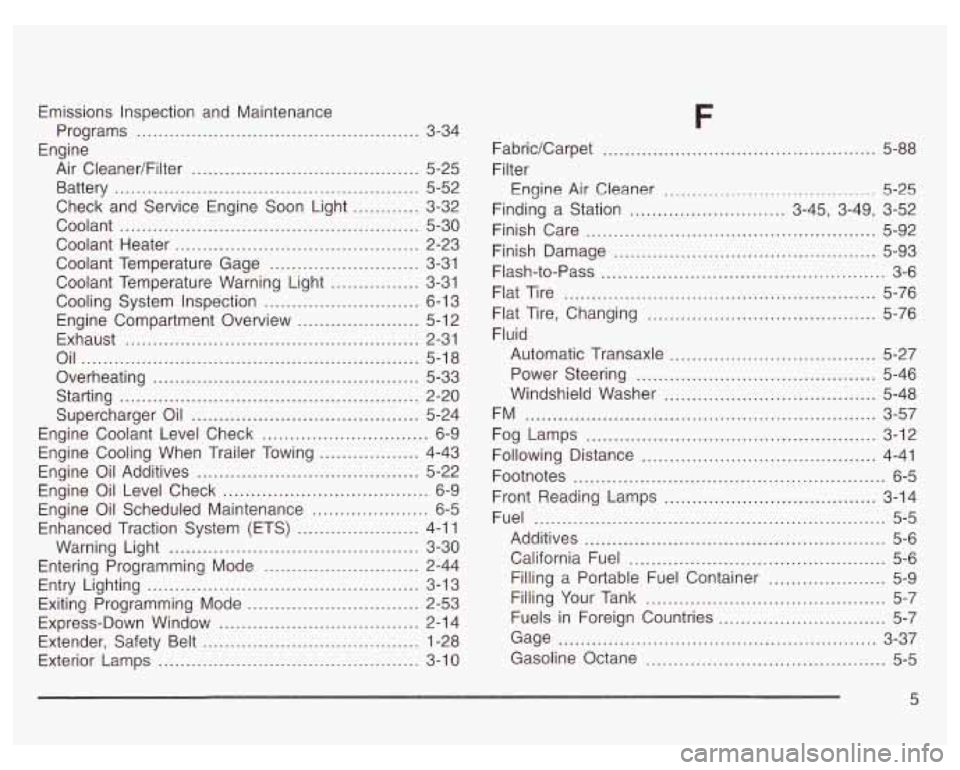
Emissions Inspection and Maintenance
Engine Programs
................................................... 3-34
Air Cleaner/Filter
......................................... 5-25
Battery
....................................................... 5-52
Check and Service Engine Soon Light ............ 3-32
Coolant
...................................................... 5-30
Coolant Heater
............................................ 2-23
Coolant Temperature Gage
........................... 3-31
Coolant Temperature Warning Light
................ 3-31
Cooling System Inspection
............................ 6-1 3
Engine Compartment Overview
...................... 5-1 2
Exhaust ..................................................... 2-31
Oil
............................................................. 5-18
Starting
...................................................... 2-20
Supercharger Oil
......................................... 5-24
Engine Coolant Level Check
.............................. 6-9
Engine Cooling When Trailer Towing
.................. 4-43
Engine Oil Additives
........................................ 5-22
Engine Oil Level Check
..................................... 6-9
Engine Oil Scheduled Maintenance
..................... 6-5
Warning Light
............................................. 3-30
Entering Programming Mode
......................... 2-44
Entry Lighting
........................ ...... 3-13
Exiting Programming Mode
.......... ...... 2-53
Extender, Safety Belt
.. ...................... 1-28
Exterior Lamps
............................................... 3-1 0
Overheating ................................................ 5-33
Enhanced Traction System (ETS)
...................... 4-1 1
Express-Down Window
................................. 2-1 4
F
, ........... FabridCarpet ........... ........... 5-88
Filter
Engine Air Cleaner ............................... :~~=:=~ 5-25
Finding a Station ............................ 3-45, 3-49, 3-52
Finish Care
.................................................... 5-92
Finish Damage
............................................... 5-93
Flash-to-Pass
................................................... 3-6
Flat Tire
........................................................ 5-76
Flat Tire, Changing
......................................... 5-76
Fluid Automatic Transaxle
..................................... 5-27
Power Steering
........................................... 5-46
Windshield Washer
...................................... 5-48
Fog Lamps
................................. , ........... 3-12
Following Distance
.......................................... 4-41
Footnotes
........................................................ 6-5
Front Reading Lamps
...................................... 3-14
Fuel
............................................................... 5-5
Additives ...................................................... 5-6
California Fuel
.............................................. 5-6
Filling a Portable Fuel Container
..................... 5-9
Filling Your Tank
........................................... 5-7
Fuels in Foreign Countries
.............................. 5-7
Gage
......................................................... 3-37
Gasoline Octane
........................................ 5-5
FM ............................................................... 3-57
5